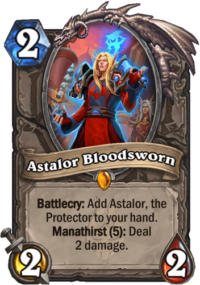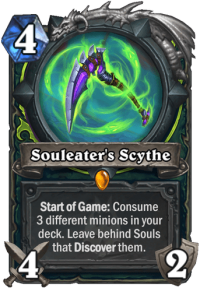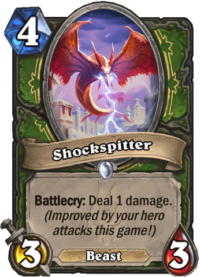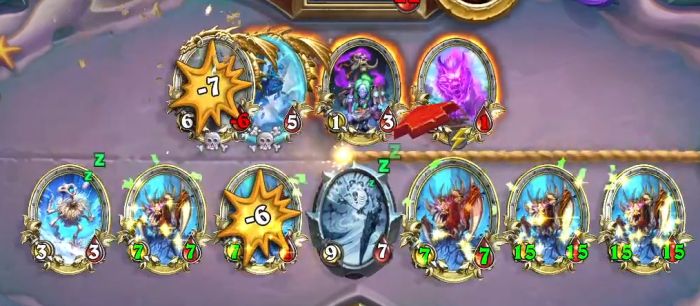The March of the Lich King theorycrafting event was played yesterday and today. In this event, many content creators had a chance to play with the new cards in advance. The event can foreshadow the upcoming meta, but not fully predict it because time is limited and all decks had to include at least ten new cards. This means that not all archetypes get a proper chance and archetypes that mainly rely on old cards cannot be played against new things. Nonetheless, the event does give a lot of information on what works and has been a subject of controversy as not all players are happy that meta development starts already before the launch.
On a smaller scale, everyone can play with the new cards before the official launch of the expansion on December 6th. This weekend, you can open your pre-order packs and play in a private Fireside Gathering. This is not quite the same thing, as you do not have a nearly complete selection of cards to build from, and you can only play with people in the same Fireside Gathering as you, so you need a real-life meet-up to actually play. However, even if you have no pre-orders, you can play with the recipe decks. That still requires another person in the same place. It’s not much, but it’s something.
Players in the event, on the other hand, had all the cards available. I was also invited to play, so in addition to watching the streams from other areas, I had a chance to test some things myself. I played for eight hours, and I have to say that it is a short time when it comes to March of the Lich King. The expansion comes with a lot of power, and in eight hours I did not even have a chance to meet all the archetypes that are talked about on social media. Buckle up your seatbelt, Dorothy, ’cause Castle Nathria is going bye-bye.
Death Knight is Strong
More than half of the games I played were against Death Knight, and I played a fair number of Death Knight games myself. Even though Death Knight deck-building does not quite live up to the hype that Blizzard tries to generate about its 68 new cards, there are multiple strong Death Knight archetypes, and it looks like the class has some depth behind it that can result in more discoveries later on.
I played various combinations of Blood and Unholy, as I had examined them in depth earlier.
The strongest Death Knight deck I played was the triple Unholy token deck:
Unholy can just go on for days and generate downright bonkers board states. This is what it looks like when you bring out your Lord Marrowgar after a long battle:
Yup, that’s 51/51 stats with Rush overall divided between five bodies. Unholy can just keep going for so long. Partially, this is powered by Death Knight’s phenomenal Discover pool. I expect School Teacher to be almost ubiquitous in Death Knight, as you just keep getting great spells one after another. Runes are also only a deck-building restriction, you can freely Discover spells from other Death Knight runes than the ones in your deck. In this Unholy deck, Necrotic Mortician also put in a lot of work by discovering cards such as extra copies of Stitched Giant and The Scourge.
As expected, Blood is the Death Knight control deck. I tried some versions with other Runes included, but in the end, triple Blood just outlasts other Death Knight control attempts thanks to Vampiric Blood.

Sire Denathrius does not grow that large in Blood, but the deck can also end games with Alexandros Mograine – yes, I think it may be playable – and Astalor Bloodsworn. Astalor is going to be the big card from March of the Lich King. Many slower decks will want to use it, and you can easily get multiple copies with either Brann Bronzebeard or Zola the Gorgon. I may need to add Zola to my list based on the event. As the first form of Astalor costs only two mana, it is trivial to copy. Then you will have multiple Astalors evolving toward their final form in your hand. Astalor may even dislodge Sire Denathrius from a triple Blood Death Knight. Sire should still find a place at least in Unholy thanks to all the tokens.
Astalor Bloodsworn is also brutal against Lightforged Cariel, as the weapon cannot reduce Astalor’s damage at all. Control Paladin was one of the weakest decks I played because Astalor was everywhere, and often in multiple copies.
While I was playing with Unholy and Blood, much of the hype I saw on other streams and on social media has been about Frost Death Knight. Here is what SuperiorDavid brought:
Frost Death Knight can freeze the board multiple times and deal a ton of direct damage from hand. I played a lot of control decks, so their damage did not feel that intimidating, but they seem to bring some serious results against many archetypes.
It is notable that in these early stages, it was the Death Knight decks focused on a single rune type that dominated. They have big, obvious payoff cards, so building a triple-rune deck is more straightforward than mixing things up. One of the most interesting questions for the new expansion will be whether some combination-rune decks can rise to a new level and overtake these monstrosities.
No-minion Demon Hunter is a Real Deck
I absolutely adore Souleater's Scythe. It is such a wonderful and innovative card that allows you to use three minions in your no-minion deck and increases the consistency with which you can find any one of those three. This enables multiple strategies for building the deck.
Here is DracoCatt’s take on the archetype:
- 1Dreadprison Glaive2

- 1Fury (Rank 1)2

- 1Sigil of Alacrity2

- 1Unleash Fel2

- 2Chaos Strike2

- 2Fel Barrage2

- 2Mark of Scorn2

- 2Multi-Strike2

- 2Predation2

- 2Spectral Sight2

- 3Aldrachi Warblades1

- 3Lady S’theno1

- 4Fel’dorei Warband2

- 4Souleater’s Scythe1

- 5Deal with a Devil2

- 6Kurtrus, Demon-Render1

- 7Xhilag of the Abyss1

- 8Jace Darkweaver1

In this version, the three minions you have are Lady S'theno, Xhilag of the Abyss, and Jace Darkweaver. Jace is pretty much a given. You will play with many Fel spells because that’s what Demon Hunters have, so there is practically no cost to adding Jace to the deck. The other two slots are more interesting.

Lady S'theno is a solid option because, again, you will have many spells in the deck. I also met a variant that used Sinful Brand with Lady S'theno and Fel'dorei Warband, using those 1/1 Rush minions to hit a double-branded big target multiple times. That may be a little too niche, and DracoCatt opts to go for a more straightforward build.
The build I played myself used Relics and Artificer Xy'mox as my third minion. It might seem difficult to infuse Xy’mox with a no-minion deck, but actually Fel'dorei Warband and Deal with a Devil provide plenty of infusion material, especially as you have three cards in your deck that can give you Xy’mox. Xy’mox is vulnerable to hand disruption though because you need to generate the minion first to infuse it before you get to play it. In that sense, DracoCatt’s approach is less vulnerable and more solid, if hand disruption is very common in the meta.
Whichever way the deck will eventually go, I had a highly positive experience playing with the archetype and believe it is a real meta contender.
Quest Hunter is Back? Or Is It Shockspitter?
Hunter gets a powerful new Arcane spell package in March of the Lich King. I immediately thought that it would revive Quest Hunter, and Quest Hunter felt really strong when I played with it.
- 1Arcane Shot2

- 1Barbed Nets2

- 1Defend the Dwarven District1

- 1Ricochet Shot2

- 1Tracking2

- 1Wound Prey2

- 2Arcane Quiver2

- 2Conjured Arrow2

- 2Furious Howl2

- 2Quick Shot2

- 2Silvermoon Farstrider2

- 2Spirit Poacher2

- 3Aimed Shot2

- 3Halduron Brightwing1

- 3Shellshot2

- 3Stag Charge2

- 3Wild Spirits2

- 4Eversong Portal2

- 4Piercing Shot2

- 5Barak Kodobane1

In this take on Arcane Quest Hunter, I ditched the Secret package and even Beaststalker Tavish and focused solely on spells. Wildseed package provides survivability and some pressure, and the new Arcane package adds a ton of board-control power in the form of Eversong Portal and some crucial card draw with Conjured Arrow. The Arrow together with Furious Howl gave me the confidence to leave Dun Baldar Bunker behind.
This is not to say that the old Secret approach would be wrong. I actually faced one where my opponent was able to set up the infinite animal companions from Tavish, and that was still painful.
I did not meet any other Hunters, but the talk of the town seems to be Shockspitter. Here is McBanterFace’s take on this new Hunter archetype:

This deck packs multiple weapons that buff up the Battlecry effect of Shockspitter. It can also make more copies of Shockspitter with Selective Breeder and Devouring Swarm.
Big minions can be taken down with Candleshot and Keeneye Spotter, while Talented Arcanist can contribute to some face damage and board control with Ricochet Shot or Eversong Portal.
I would have loved to see these two takes on Arcane Hunter go head-to-head, but I guess we’ll have to wait until the expansion launch for the ultimate showdown.
Low-curve Tempo and Burst Damage Decks
While there were still games that were decided by Theotar, the Mad Duke and Sire Denathrius, March of the Lich King brings a lot of lethality to multiple classes. There are many deck candidates out there that cap out at a mere four or five mana. They are not necessarily pure face decks. Instead, they have interesting twists and turns that enable dealing damage under tough conditions and just bursting down opponents.
McBanterFace played multiple such decks during the event, such as these Arcane Mage and Concoction Rogue:
Arcane Mage is able to create a vast number of Arcane Bolts, and when they are combined with Spell Damage from Aegwynn, the Guardian and made free with Magister's Apprentice, the burst potential of the deck is substantial. I’m still uncertain whether this can be a real thing, but it is clear by now that it can blast away quite well.
As for the Concoction Rogue, I met a couple of variants of the list, and they all shared the same main features: Concoctions, Sinstone Graveyard, and a really low curve. Here is McBanterFace’s version:
The deck can play cards at an incredible pace, and when I played a slow deck against it, I was impressed how the Concoctions just kept coming from Potionmaster Putricide as the Rogue killed their own minions to keep getting more cards. The traditional Edwin Rogue has been struggling a bit in the meta, and the new cards make it faster and deadlier and potentially enable it to compete again.
Priest has also changed. Sure, I still met Zetalot playing a slow Priest deck, but apart from him, it was all Shadow or Sister Svalna OTK. OTK Priest looks scary, but I wonder if it will be strong enough in the end. It only has one trick, and people can learn to play around that to an extent. But oh boy, it can be scary fast when it all comes together.
This is what the OTK looks like:
Overall Meta Thoughts
March of the Lich King adds a lot of lethality to the game. Decks like Frost Death Knight, Arcane Mage, Shockspitter Hunter, Concoction Rogue, and OTK Priest will aim to end games early and never give Sire Denathrius a chance.
On the other hand, if decks like Blood Death Knight and Armor Ramp Druid are able to survive the initial onslaught, they also have more tools to end games at their disposal. Astalor Bloodsworn is the nuts for any slow decks: board control, additional survivability, and a big burst of damage at the end in a form that is quite easy to get multiple copies of. It’s busted.
If those slow decks can survive some of the burst, midrange decks will have an opening in the meta as well. Especially No-minion Demon Hunter looks solid.
Some of the Castle Nathria mainstays look threatened. Aggro Druid felt much weaker now than in Castle Nathria, which sounds like bad news for any budget players. Unholy Death Knight is the most likely budget deck to succeed in the new meta. Control Paladin also felt weaker than ever. If Paladin is to have any chance in the new meta, it will come from aggressive lists or, less likely, some kind of Midrange Dragon build.
There are also some old decks that could not be played because of deck-building rules at the event. Naga Priest, Imp Warlock, Curse Imp Warlock, and Beast Hunter will have to wait until the expansion launch to test their mettle against the newcomers. Personally, I would bet on the newcomers this time.
March of the Lich King will be an influential expansion. There is a surge of new win conditions coming to the game, and Sire Denathrius may prove to be too slow for the upcoming meta. On the other hand, if any slow decks survive the burst, Sire Denathrius remains a powerful win condition that they will want to use unless they jump ship to Astalor Bloodsworn. Then again, why not both?
Leave a Reply
You must be logged in to post a comment.
































































































How does a ‘Sister Svalna OTK’ work?
Oh god I’m dumb. The video was so prominent I thought it was an Ad… 🙁 nevermind.